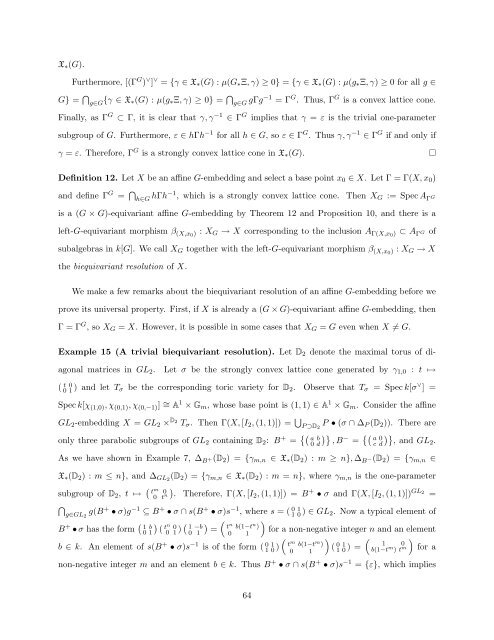Equivariant Embeddings of Algebraic Groups
Equivariant Embeddings of Algebraic Groups
Equivariant Embeddings of Algebraic Groups
You also want an ePaper? Increase the reach of your titles
YUMPU automatically turns print PDFs into web optimized ePapers that Google loves.
X ∗ (G).<br />
Furthermore, [(Γ G ) ∨ ] ∨ = {γ ∈ X ∗ (G) : µ(G ∗ Ξ, γ) ≥ 0} = {γ ∈ X ∗ (G) : µ(g ∗ Ξ, γ) ≥ 0 for all g ∈<br />
G} = ⋂ g∈G {γ ∈ X ∗(G) : µ(g ∗ Ξ, γ) ≥ 0} = ⋂ g∈G gΓg−1 = Γ G . Thus, Γ G is a convex lattice cone.<br />
Finally, as Γ G ⊂ Γ, it is clear that γ, γ −1 ∈ Γ G implies that γ = ε is the trivial one-parameter<br />
subgroup <strong>of</strong> G. Furthermore, ε ∈ hΓh −1 for all h ∈ G, so ε ∈ Γ G . Thus γ, γ −1 ∈ Γ G if and only if<br />
γ = ε. Therefore, Γ G is a strongly convex lattice cone in X ∗ (G).<br />
Definition 12. Let X be an affine G-embedding and select a base point x 0 ∈ X. Let Γ = Γ(X, x 0 )<br />
and define Γ G = ⋂ h∈G hΓh−1 , which is a strongly convex lattice cone.<br />
Then X G := Spec A Γ G<br />
is a (G × G)-equivariant affine G-embedding by Theorem 12 and Proposition 10, and there is a<br />
left-G-equivariant morphism β (X,x0 ) : X G → X corresponding to the inclusion A Γ(X,x0 ) ⊂ A Γ G<br />
<strong>of</strong><br />
subalgebras in k[G]. We call X G together with the left-G-equivariant morphism β (X,x0 ) : X G → X<br />
the biequivariant resolution <strong>of</strong> X.<br />
We make a few remarks about the biequivariant resolution <strong>of</strong> an affine G-embedding before we<br />
prove its universal property. First, if X is already a (G × G)-equivariant affine G-embedding, then<br />
Γ = Γ G , so X G = X. However, it is possible in some cases that X G = G even when X ≠ G.<br />
Example 15 (A trivial biequivariant resolution). Let D 2 denote the maximal torus <strong>of</strong> diagonal<br />
matrices in GL 2 . Let σ be the strongly convex lattice cone generated by γ 1,0 : t ↦→<br />
( t 0<br />
0 1 ) and let T σ be the corresponding toric variety for D 2 . Observe that T σ = Spec k[σ ∨ ] =<br />
Spec k[χ (1,0) , χ (0,1) , χ (0,−1) ] ∼ = A 1 × G m , whose base point is (1, 1) ∈ A 1 × G m . Consider the affine<br />
GL 2 -embedding X = GL 2 × D 2<br />
T σ . Then Γ(X, [I 2 , (1, 1)]) = ⋃ P ⊃D 2<br />
P • (σ ∩ ∆ P (D 2 )). There are<br />
only three parabolic subgroups <strong>of</strong> GL 2 containing D 2 : B + = {( )}<br />
a b<br />
0 d , B − = {( )}<br />
a 0<br />
c d , and GL2 .<br />
As we have shown in Example 7, ∆ B +(D 2 ) = {γ m,n ∈ X ∗ (D 2 ) : m ≥ n}, ∆ B −(D 2 ) = {γ m,n ∈<br />
X ∗ (D 2 ) : m ≤ n}, and ∆ GL2 (D 2 ) = {γ m,n ∈ X ∗ (D 2 ) : m = n}, where γ m,n is the one-parameter<br />
subgroup <strong>of</strong> D 2 , t ↦→ ( )<br />
t m 0<br />
0 t . n Therefore, Γ(X, [I2 , (1, 1)]) = B + • σ and Γ(X, [I 2 , (1, 1)]) GL 2<br />
=<br />
⋂<br />
g∈GL 2<br />
g(B + • σ)g −1 ⊆ B + • σ ∩ s(B + • σ)s −1 , where s = ( 0 1 1<br />
0 ) ∈ GL 2. Now a typical element <strong>of</strong><br />
B + • σ has the form ( )<br />
1 b<br />
0 1 (<br />
t n 0<br />
0 1 ) ( ) ( )<br />
1 −b<br />
0 1 =<br />
t n b(1−t n )<br />
for a non-negative integer n and an element<br />
0 1<br />
( ) ( )<br />
b ∈ k. An element <strong>of</strong> s(B + • σ)s −1 is <strong>of</strong> the form ( 0 1 1<br />
0 ) ( 0 1 1<br />
0 ) = 1 0<br />
b(1−t m ) t m for a<br />
t m b(1−t m )<br />
0 1<br />
non-negative integer m and an element b ∈ k. Thus B + • σ ∩ s(B + • σ)s −1 = {ε}, which implies<br />
64
















